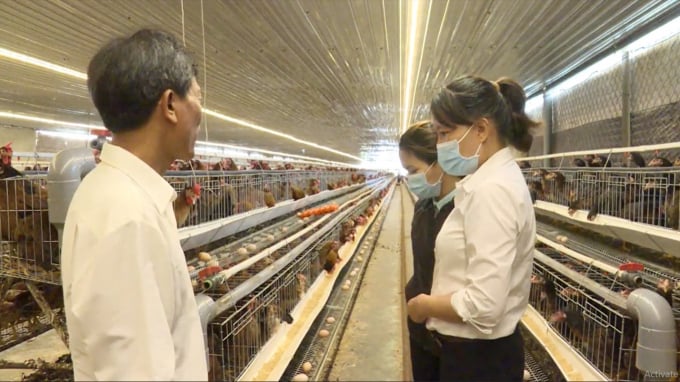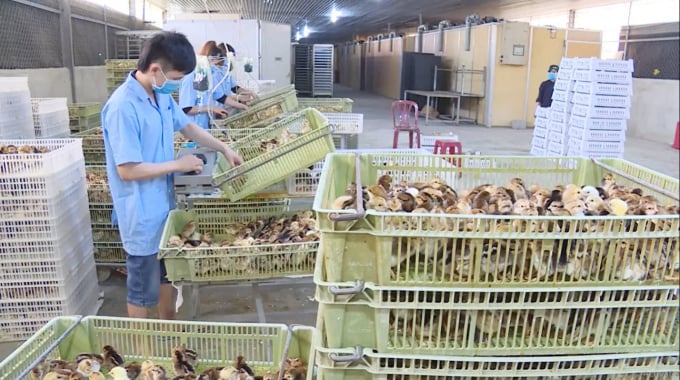June 7, 2025 | 02:04 GMT +7
June 7, 2025 | 02:04 GMT +7
Hotline: 0913.378.918
June 7, 2025 | 02:04 GMT +7
Hotline: 0913.378.918
Vice Chairman of Khanh Hoa Provincial People's Committee, Mr. Dinh Van Thieu, recently has signed a decision approving the province’s livestock development strategy by 2030.

Khanh Hoa Province will head towards a sustainable livestock development, enhance added-value production and boost climate change adaptation. Photo: LT.
Accordingly, Khanh Hoa will promote local potentials and advantages for sustainable development and climate change adaptation, increase added values ensuring biosecurity and disease prevention, boost environmental protection and food safety, and enhance humane behavior toward livestock to meet market demand in the province and the whole country. The strategy will help create jobs, increase local income and contribute to ensuring nutrition security for people in the areas…
Specifically, the development orientation of the livestock industry must comply with Provincial People's Council’s Resolution No. 17 dated December 8, 2020 which regulates that the inner cities and towns’ residential areas are not allowed to breed and raise swiftlets. The strategy should also follow Decision 02 dated 9/3/2021 of the Provincial People's Committee promulgating the Regulation on livestock density in Khanh Hoa by 2030.
In pig farming, the development of high-yielding breeds should be carried out in the direction of industrial farms associated with disease safety, bio-safety and organic livestock production reducing the risk of environmental pollution. The total herd of pigs should regularly maintain 400,000-450,000 heads, of which, the number of sows is from 25,000 to 28,000 heads and farmed pig herd accounts for over 85%.

In pig farming, Khanh Hoa Province will develop industrial high-yield breeding farms ensuring disease safety. Photo: CD.
Poultry raising will also be developed under the form of industrial farms associated with disease safety and biosafety with a focus on promoting the strengths of local livestock breeds such as the Ri chicken breed in Ninh Hoa. Along with that, improving productivity and quality, limiting environmental pollution, encouraging the development of livestock models of linkage chains from production to slaughter and consumption. The total chicken herd should maintain regularly from 3.5 to 4.0 million heads, of which about 45-50% are raised by industrial methods.

Home swiftlet raising in Khanh Hoa. Photo: KS.
The cow herd is maintained stably at a scale of 80,000-100,000 heads, of which about 20% are raised on farms. Breeding swiftlets expects to reach the nest yield of about 3 tons by 2025 and 5 tons by 2030. In terms of animal feed, the scale and capacity of industrial processing factories will be stable by 2030 from 30,000-40,000 tons, with the actual output from 65-70 tons/year. Besides, advantages in the use of biological products to replace antibiotics and chemicals in livestock and supplementary feed production are encouraged to improve the nutritional value of agricultural and aquatic by-products...
To develop livestock production according to the above orientation, Khanh Hoa has proposed 10 implementation solutions. Firstly, groups of policies will be completed for promulgation such as those on land use for livestock development, financial and credit support, trade and agricultral livestock promotion programs on close-chain and VietGAP livestock establishments...

Khanh Hoa will synchronously mobilize solutions to develop livestock production following the targeted strategic direction. Photo: LT.
Secondly, the province will improve its capacity in disease prevention and control, and environmental protection and encourage the establishments of disease-free facilities, especially those for breed production and livestock farms.
Thirdly, the application and transfer of new high and advanced biotechnologies will be carried out in the fields of livestock breeds, animal feed, veterinary drugs, vaccine production, traceability, slaughtering, processing, disease prevention and control, and livestock environmental treatment.
Fourthly, the province will focus on improving productivity and quality of livestock breeds. Fifthly, it will improve the quality but reduce the cost of animal feed. Sixthly, the capacity of slaughtering and processing livestock products will be increase by reorganizing in a centralized direction ensuring all conditions of veterinary hygiene, food safety, environmental protection and humane behavior towards animals.
Seventhly, the province will boos skills of veterinary staff at all levels, especially in local areas in the fields of management, husbandry techniques, disease management and food safety through vocational training programs. Eighthly, the application of high and advanced technologies on mechanical, chemical and biotechnological industries will be enhanced with the installments of equipment for slaughtering and processing so that to replace the imported sources.
Ninethly, a renovation will be undertaken in livestock production in the direction of specialization, modernization and efficiency associated with linkage chains with the promotion for leading role of enterprises, associations and co-operatives. Tenthly, it is to strengthen the state management capacity in the livestock and veterinary sectors.
Specific targets of livestock strategy
According to this livestock strategic decision, average growth rates of production value in periods of 2021 – 2025 and 2026 – 2030 will reach between 4-5%/year and 3-4%/year, respectively. The output of carcass of all kinds by 2025 will stand at 70,000-75,000 tons, of which pork will be 75-77%, poultry meat will be 12-13%, and grass-fed cattle will be 9-10%.
By 2030, the figure will increase to 80,000-85,000 tons, of which pork will be 74-76%, poultry will be 13-14%, and grass-fed cattle will be 9-10%.
For egg production, by 2025, it will reach 180-200 million eggs. By 2030, it will increase to about 250 million.
The average livestock product/person/year by 2025 will reach 50-55 kg of meat of all kinds and 180-200 eggs. By 2030, the figure wil rise to 58 - 60kg of meat of all kinds and 220 - 250 eggs. The proportion of cattle and poultry that are industrially slaughtered will reach about 20-40% by 2025, and about 40-60% by 2030, respectively. Along with that, the proportion of cattle and poultry processed meat will account for about 10% by 2025, about 30% by 2030 compared to total meat production.
Translated by Linh Nguyen

(VAN) Dong Thap has launched a meeting in response to the Action Month for the Environment under the theme 'Live Green - Join Hands for a Green Economy' at Tram Chim National Park.

(VAN) The ocean has the capacity to absorb millions of tons of carbon, provided that mangrove forests, coral reefs, and biodiversity are protected.

(VAN) Technology is redrawing the map of Vietnamese aquaculture: more modern, greener, and more sustainable.

(VAN) Novel process harnesses machine learning to reveal groups of genes that determine how efficiently plants use nitrogen.

(VAN) Several scientists and farmers are experimenting with soil treatment in some key durian-growing regions such as Cai Lay (Tien Giang), Dak Song, Gia Nghia, and Dak R’lap (Dak Nong).
/2025/05/25/4127-3-073637_820.jpg)
(VAN) Thanks to the promotion from an FAO-implemented project, vegetable production in greenhouses in Moc Chau has seen strong development, from 1.5 hectares in 2021 to nearly 50 hectares in 2024.

(VAN) FAO has recently supported USD 140,000 to implement the project 'Risk mitigation human-animal interface risks through disease control initiatives in pig farming.'